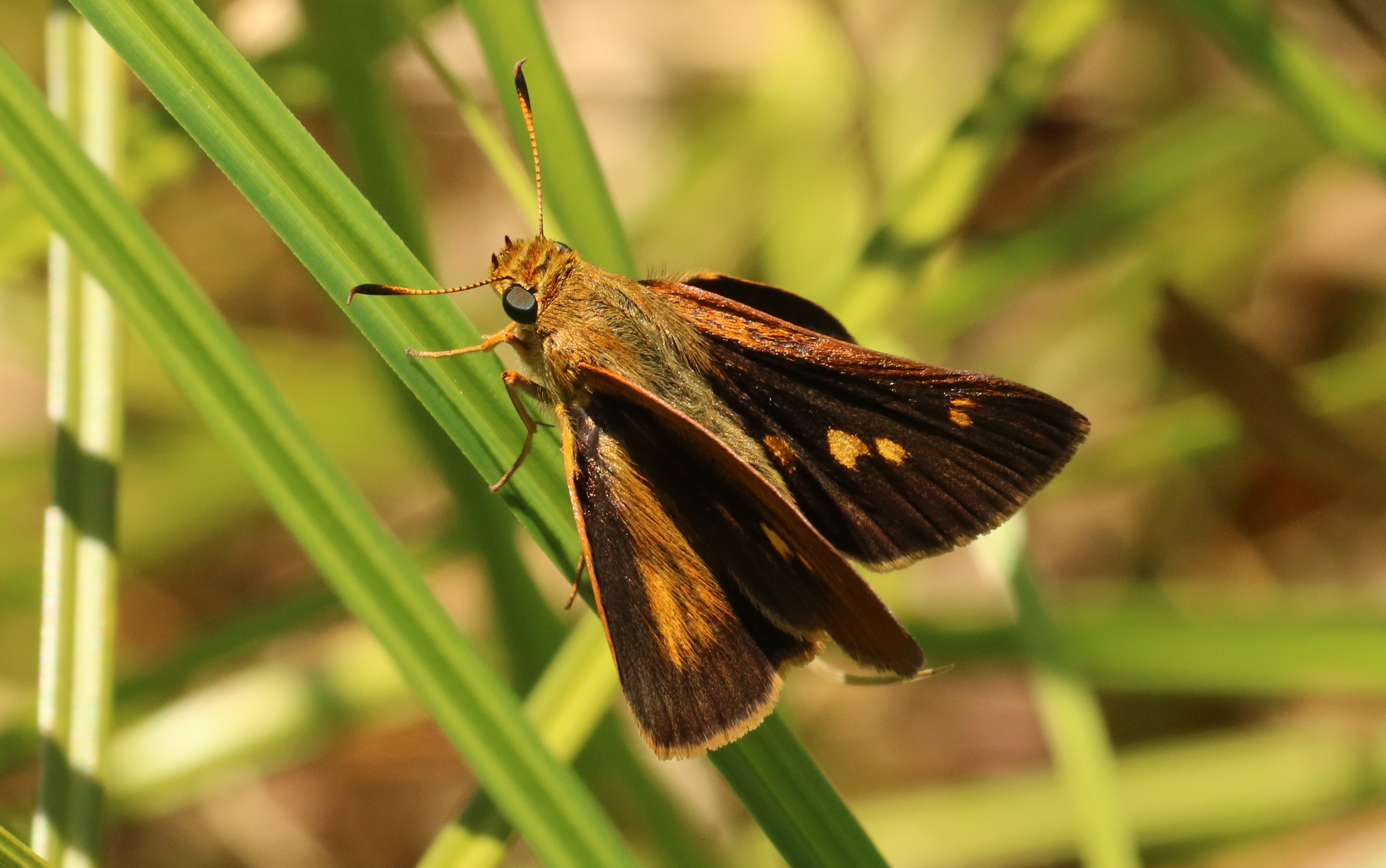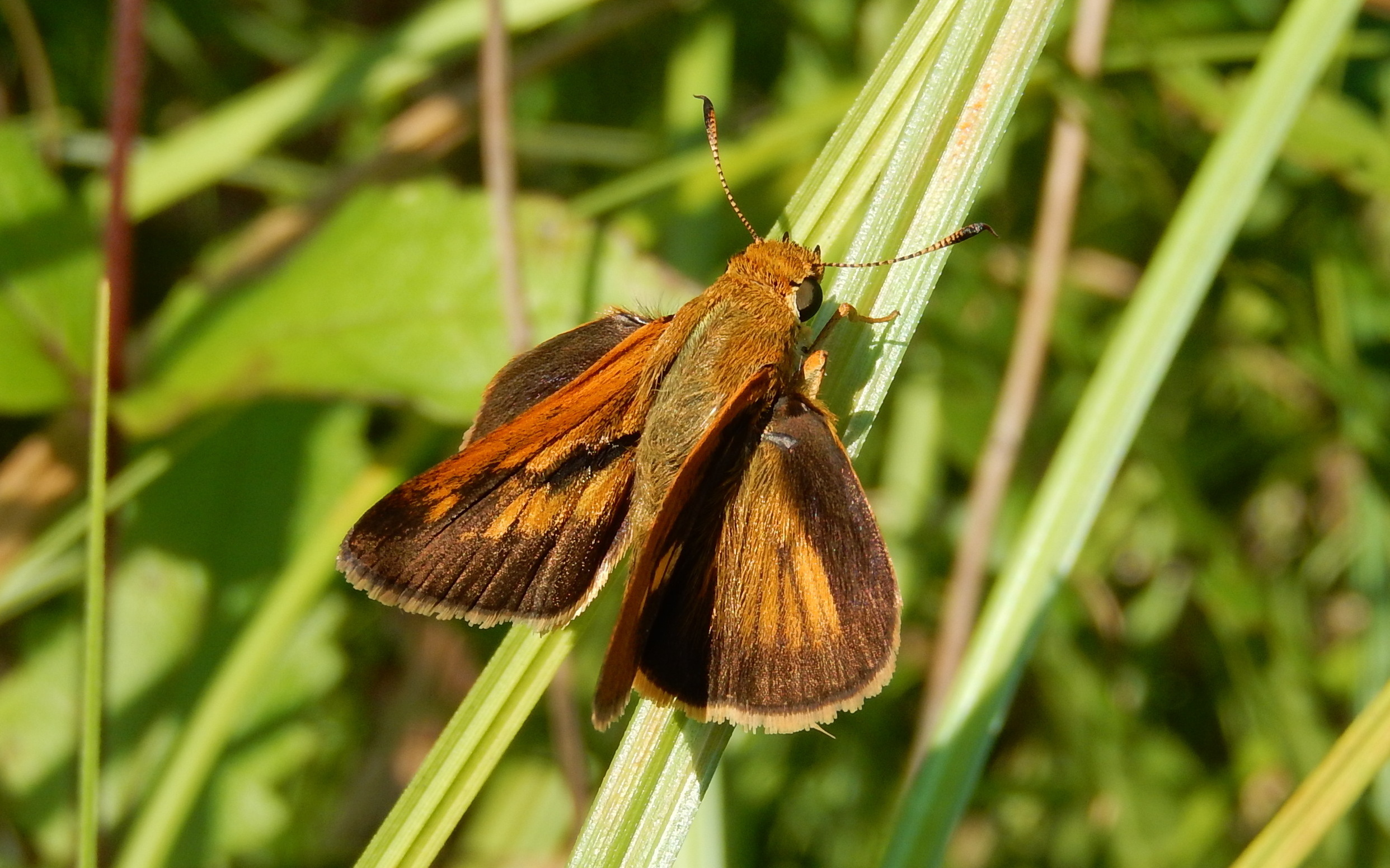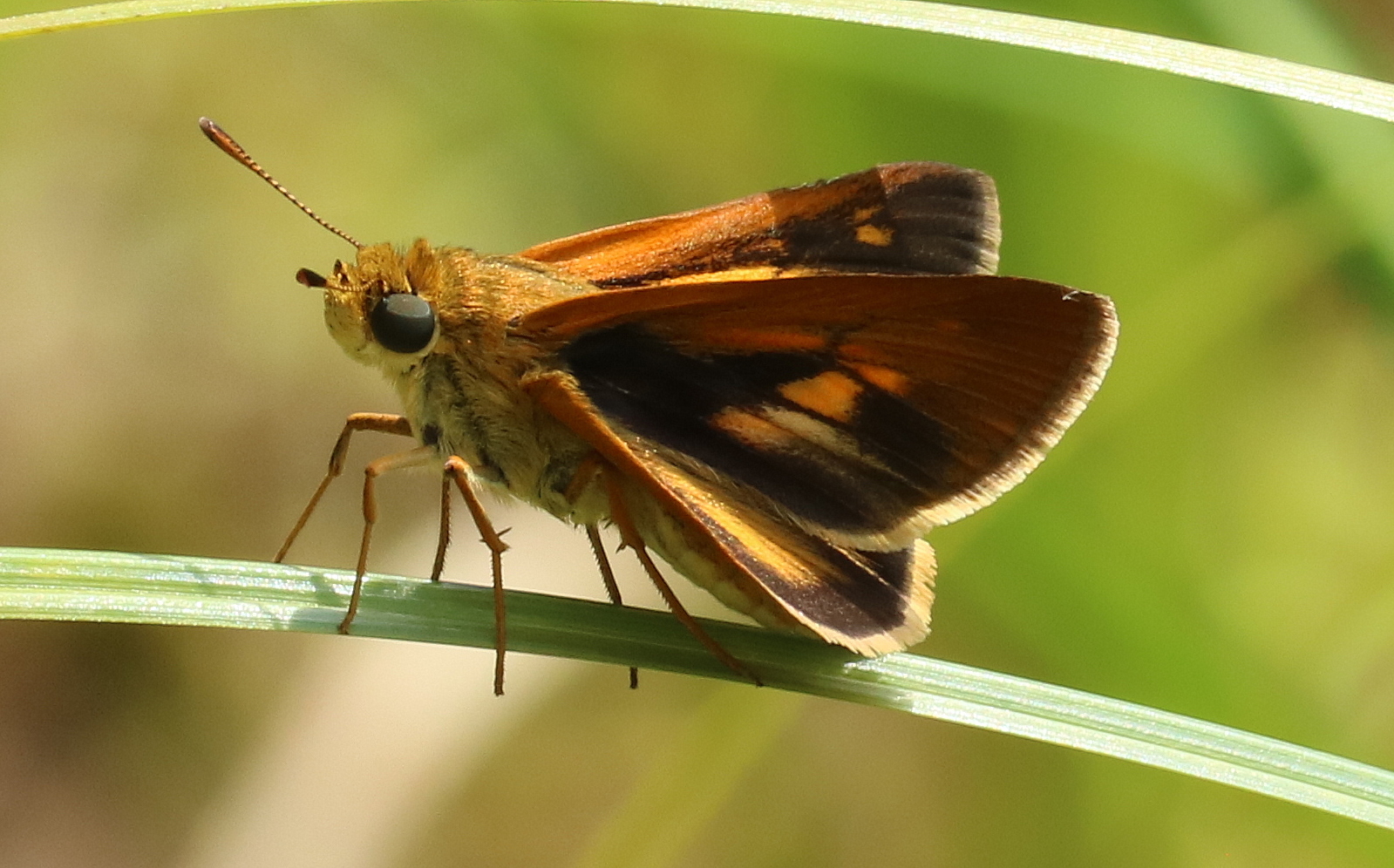[Update (8-3-21): In response to Jack Miller’s post below, Dale Schweitzer has kindly provided his own thoughts about the host plant for Euphyes dion in our area. See the end of this post for his comments.
Any observer observing ovipositing by this species should attempt to photo it and also include full shots of the plant involved and post on our Sightings Log. We could help solve this mystery! jc]
Dion skipper has an interesting history in the SJBP log. Since the log began in 2008, Dions have been found in six of our eight South Jersey counties: CMY, ATL, CUM, CAM, BUR, and OCN; only SAL and GLO have not reported the species. CMY has had by far the most reports with 122; ATL has had 9 with only 3 reports north of the Tuckahoe River area; BUR has had 7; CUM has had 5 reports; and CAM has had 1 report (2013).
From 2008 to 2011 we collected 19 reports from three counties (CMY, BUR, and ATL) with a total number of individuals of approximately 30 to 40 (numbers do not exist for 2008). By 2011, the vast majority of reports started coming from CMY with peak years of 20 reports in 2016 and the log’s record of 33 reports in 2017. Reports of 20 to 40 individuals became common with peak number of individuals in reports as high as 144 (2012), 60 (2017), 131 (2019), and the log’s record of 350 in 2020.
Most likely, the low number of reports from the log’s early years can be attributed to a learning process. As more locations were discovered, an understanding of what comprised suitable habitats increased. “New” locations soon became “old” locations that were visited each year, thus increasing the number of reports and the number of individuals seen. Also, particularly in CMY, log participants realized that there were dozens of locations that were suitable for Dions.
Dion numbers in Cape May County fluctuate and sometimes these fluctuations are dramatic. Boggy areas in power line cuts offer prime habitat for Dions. However, when these lines are mowed and/or “shaved,” populations may crash. An example of this is the power line that extends from Route 610 to Corson’s Tavern Road. On July 22 2017, 68 individuals were reported from this location. In 2018, after being mowed and having significant work completed with heavy equipment, the site’s high single-day count was five on July 25. Conversely, the Hand Avenue colony location has not been mowed in years, and the population there has been growing recently. The colony peaked with a report of 350 individuals on July 25, 2020.
It also appears that the species may experience cyclical variations. CMY’s record number of 33 reports in 2017 was followed by 6 reports in each of 2018 and 2019 with four of the 12 reports in 2018 and 2019 being single individuals from yard gardens. Only the Hand Avenue site thrived during 2018 and 2019.
Dions do not mind straying far from their host plants. An observer may encounter a Dion almost anywhere in the Cape. They have been reported at Cape May Point and single individuals have been found in dozens of locations. One individual was found in the middle of Wharton St Forest far from where any colony has been discovered. It is possible that degradation in host locations can be responsible for the species abandoning some sites and relocating to other sites where the host plants exist. In 2021, two locations in the Rio Grande area apparently have been abandoned. It is clear that the sedges in one of the locations spent a long period of time under water which resulted fewer and weaker plants. However, there is a small area within two miles of the previously mentioned sites where the host plant is healthy, and for the first time in five years Dions have appeared there.
Cech and Tudor (in their Butterflies of the East Coast) list “various sedges” as host plants including Carex lacustris and Scirpus cyperinus. Glassberg (in his Butterflies Through Binoculars) simply lists “Carexs.” It is likely that the most common host plant in southern New Jersey for Dions is Carex lacustris. This sedge is widely distributed and can be found in bogs, vernal wetlands and along brackish marshlands. However, large patches of sedges does not guarantee the presence of Dions. I know of a number of locations where C. lacustris thrives that I have searched for years, but have not seen Dions. It is interesting to note that most of these locations are near brackish tidal areas that can be flooded by storm-produced tidal flooding. On the other hand, it may only take a few hundred square feet of C. lacustris in order for a colony to exist for years. The Davies Sports Complex in CMY provides an example of one of these small colonies. Most colonies seem to need both access to sunlight and proximity to wooded edges.
Glassberg writes that there are distinct northern and southern populations. He describes the behavior of northern populations as “nervous and active” and southern populations as “sluggish” (92). Cech and Tudor write that Dions are “shy and reclusive—challenging to locate, and harder still to approach” (296). They also note that they are “limited to small colonies with low population density” (296). These comments suggest the Dions of SJ are of the southern populations. Our individuals are often sluggish and can remind one of fireflies as they slowly drift through and over their host plants. They are often cooperative with photographers and will allow close approach. This is not to say that they are incapable of bursts of rapid and excited flight when disturbed — which often brings them back to their starting point. Another support for the idea that our Dions are of the southern populations is that South Jersey bogs are acidic while northern colonies prefer calcareous fens.

New Jersey Dions are single-brooded with third-stage caterpillars overwintering. Is it possible that yearly population fluctuations are the result of the precarious locations of host plants? There are years when water levels stay high in South Jersey bogs and wetlands which might affect caterpillar survival rates.
Although finding Dions in SJ is easier now than it was a decade ago, they remain a species that warrants study.
Log Reports, 2008- 2020
2008
CMY– 3 reports (number of individuals unknown) (7/15 – 7/25)
2009
BUR – 4 reports of 1, 4, 1 and 1; all from Franklin Parker Preserve (8/3 – 8/18)
2010
CMY 1 report of 1; Belleplain area
ATL 1 report of 2; Head of River/Tuckahoe River*
BUR 1 report of 1; FPP (6/27 – 7/17)
* note: There are many reports from Head of River and the Tuckahoe River that create some confusion. The river separates ATL and CMY counties and observers may on occasion be reporting the same individuals but from two different counties.
2011
CMY 9 reports, some of 6 or 7 individuals.
On 7/10 Mike Crewe reports “7th site for Dion skipper this year in CMY, so far.”
ATL 1 report of 1; Hirst Ponds, Galloway (7/6 – 7/19)
2012
CMY 16 reports.
On 7/14, a report of 117 in the Belleplain (Johnson/Kerling) area with three other nearby areas raising the day’s total to 144. This was more Dions in one day than the log had reported in its first four years.
First report of Dion in yard (Allen) from CMCH on 7/15, and second report of Dion in yard (Sutton) from Goshen on 7/19.
ATL 1 report of 28 from Tuckahoe River area.
(7/15 – 7/24)
2013
CMY 7 reports; high count of 37 from Tuckahoe River
CAM 1 report of 8 from West Jersey Bogs
ATL 1 report of 1
1 new yard record in Port Republic (Connor)
OCN 1 report of 1 from Klot’s Bog (7/9 – 7/28)
2014
CMY 10 reports with high count of 42 from Head of River
ATL 1 report of 45 from Head of River
CUM 2 reports Haleyville Rd.
OCN 1 report of 1 from Warren Grove (7/18 – 8/13)
2015
CMY 2 reports with high count of 30 from Lizard Tail (7/22 – 7/24)
2016
CMY 20 reports with a high count of 30 from Lizard Tail. Totals for the year were skewed in that there were 9 reports from Lizard Tail. 4 reports from Tuckahoe River with a high count of 4.
1 new yard record in Petersburg (Miller)
CUM 1 report of 7 from Bear Swamp (7/14 – 8/20)
2017
CMY 33 reports from as many as 16 locations (SJBP log’s all time high number of reports).
High counts of 44 from Lizard Tail, 60 from Corson’s Tavern power line, and 28 from Hand Ave.
No reports from Belleplain area or Head of River/Tuckahoe River area.
1 new yard record in CMCH (Amesbury) and two other yard records (Allen and Miller)
CUM 1 report of 1 from near Fairton. (7/10 – 8/12)
2018
CMY 6 reports with a high count of 18 from Hand Ave.
1 yard report in CMCH (Amesbury)
ATL 1 report of 1 from Wharton St Forest (7/12 – 8/22)
2019
CMY 6 reports with a high count of 131 from Hand Ave; all other reports were singletons.
3 reports of yard records: Amesbury 2 (CMCH) and Miller 1 (Petersburg)
ATL 2 reports with a high count of 12 from Tuckahoe River.
CUM 1 report of 1 from Glades Preserve. (7/12 – 8/2)
2020
CMY 9 reports with a high count of 350 from Hand Ave (SJBP log’s all time high number of individuals from 1 report).
5 reports of yard records: Amesbury 3 (CMCH), Allen 1 (CMCH) and Sutton 1 (Goshen)
ATL 1 report of 1 from Port Republic (yard record; Connor)
BUR 2 reports with a high count of 5 from Franklin Parker Preserve (this was the first report from BUR since 2010 which was also from FPP).
Jack Miller (July 27, 2021)
Comment from Dale Schweitzer, [added 8-3-31]
Hi Jack et al.
Re Euphyes dion, nearly half of its range is south of Carex lacustris. I have seen dion with Carex lacustris in nw NJ (Carex id is?), NY, CT, and I’m pretty sure w.MA. Forbes (1960) gave the foodplant for E. dion alabamae as Carex striata which some of you may know locally as Carex walteriana, the name I first knew it as.
With one exception I am pretty sure that is the sedge I see it with in south Jersey. The exception was two a few minutes apart around Scirpus cyperinus in a ditch near the Port Norris fire station. I have seen no others there on many visits since 1989-2021, almost daily 1989-ca. 2005 since the site was on my dog-walk route. C. lacustris was never present any other place I saw E. dion down here.
I suspect, but definitely don’t know, that south Jersey dion are that southern “subspecies”. I have no opinion whether that taxon is worthy of subspecies, full species, or synonym status. But besides the differences in behavior you note, South Jersey dion also fly rather late, mainly about July 20 to August 5, the earliest I have seen (a photo) is about July 10. It’s not unusual to see single dion around here out of habitat on flowers such as milkweeds if buttonbush is not flowering in the habitat.. I assume they can find their way home.
Feel free to share this message. Any actual oviposition or larval records would be interesting if the sedge identity is known.
Dale S.



